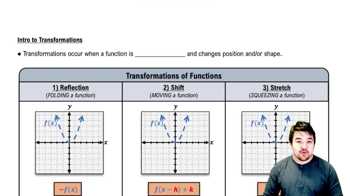Table of contents
- 0. Functions7h 52m
- Introduction to Functions16m
- Piecewise Functions10m
- Properties of Functions9m
- Common Functions1h 8m
- Transformations5m
- Combining Functions27m
- Exponent rules32m
- Exponential Functions28m
- Logarithmic Functions24m
- Properties of Logarithms34m
- Exponential & Logarithmic Equations35m
- Introduction to Trigonometric Functions38m
- Graphs of Trigonometric Functions44m
- Trigonometric Identities47m
- Inverse Trigonometric Functions48m
- 1. Limits and Continuity2h 2m
- 2. Intro to Derivatives1h 33m
- 3. Techniques of Differentiation3h 18m
- 4. Applications of Derivatives2h 38m
- 5. Graphical Applications of Derivatives6h 2m
- 6. Derivatives of Inverse, Exponential, & Logarithmic Functions2h 37m
- 7. Antiderivatives & Indefinite Integrals1h 26m
- 8. Definite Integrals4h 44m
- 9. Graphical Applications of Integrals2h 27m
- 10. Physics Applications of Integrals 2h 22m
0. Functions
Transformations
Problem 53e
Textbook Question
Shifting and Scaling Graphs
Suppose the graph of g is given. Write equations for the graphs that are obtained from the graph of g by shifting, scaling, or reflecting, as indicated.
e. Stretch vertically by a factor of 5
 Verified step by step guidance
Verified step by step guidance1
Start with the original function g(x). To stretch the graph vertically, you will multiply the entire function by a constant factor.
Identify the factor by which you want to stretch the graph vertically. In this case, the factor is 5.
Multiply the function g(x) by the factor 5. This means you will write the new function as 5 * g(x).
Understand that multiplying the function by 5 will make all the y-values of the graph five times larger, effectively stretching the graph vertically.
The equation for the vertically stretched graph is y = 5 * g(x). This represents the transformation applied to the original graph.
 Verified video answer for a similar problem:
Verified video answer for a similar problem:This video solution was recommended by our tutors as helpful for the problem above
Video duration:
1mPlay a video:
Was this helpful?
Key Concepts
Here are the essential concepts you must grasp in order to answer the question correctly.
Vertical Stretch
A vertical stretch occurs when the output values of a function are multiplied by a factor greater than 1. For example, if the function g(x) is transformed to 5g(x), every point on the graph of g is moved away from the x-axis by a factor of 5, effectively stretching the graph vertically. This transformation increases the height of the graph while maintaining the same x-coordinates.
Recommended video:

Intro to Transformations
Function Transformation
Function transformations involve altering the graph of a function through shifts, stretches, or reflections. These transformations can be represented mathematically by modifying the function's equation. Understanding how to apply these transformations allows one to predict the new position and shape of the graph based on the original function.
Recommended video:

Intro to Transformations
Graph of a Function
The graph of a function visually represents the relationship between the input (x-values) and output (y-values) of the function. Each point on the graph corresponds to a pair (x, g(x)). Analyzing the graph helps in understanding the behavior of the function, including its intercepts, slopes, and overall shape, which are crucial when applying transformations like stretching or shifting.
Recommended video:

Graph of Sine and Cosine Function

 5:25m
5:25mWatch next
Master Intro to Transformations with a bite sized video explanation from Nick
Start learningRelated Videos
Related Practice

